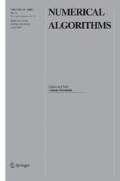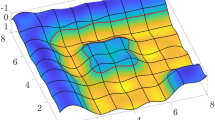Abstract
In this paper, we propose a fast and stable evaluation method for the analytic derivatives of splines generated by the 7-direction quartic box-spline. We can maintain the spline structure by determining the derivative functions that can be represented as finite differences of box-splines defined by the sub-directions. Thus, the evaluation overhead can be reduced. We demonstrate that the first and second derivative functions are composed of only three cubic and six quadratic polynomial formulas, respectively, owing to their symmetries. Moreover, for each derivative order, all of the required functions possess change-of-variables relation with each other. Therefore, additional formulas are not required. As a result, for a given point, we only need to evaluate one quartic, three cubic, and six quadratic polynomial formulas to evaluate its spline value, gradient, and Hessian, respectively. This reduction in cases is especially advantageous for graphics processing unit (GPU) kernels, where conditional statements significantly degrade performance. To verify our technique, we implemented a real-time curvature-based GPU isosurface raycaster. Compared with other implementations, our method (i) achieves superior accuracy, (ii) is more than four times faster, and (iii) requires less than 15% of memory.






Similar content being viewed by others
References
Blu, T., Unser, M.: Quantitative fourier analysis of approximation techniques. I. interpolators and projectors. IEEE Trans. Signal Process. 47(10), 2783–2795 (1999). https://doi.org/10.1109/78.790659
Bogner, S., Rüde, U., Harting, J.: Curvature estimation from a volume-of-fluid indicator function for the simulation of surface tension and wetting with a free-surface lattice Boltzmann method. Phys. Rev. E 93(4), 043,302 (2016). https://doi.org/10.1103/PhysRevE.93.043302
Coeurjolly, D., Lachaud, J.O., Levallois, J.: Multigrid convergent principal curvature estimators in digital geometry. Comput. Vis. Image Underst. 129(4), 27–41 (2014). https://doi.org/10.1016/j.cviu.2014.04.013
Condat, L., Möller, T.: Quantitative error analysis for the reconstruction of derivatives. IEEE Trans. Signal Process. 59(6), 2965–2969 (2011). https://doi.org/10.1109/TSP.2011.2119316, http://ieeexplore.ieee.org/document/5720324/
de Boor, C.: On the evaluation of box splines. Numer. Algor. 5(1–4), 5–23 (1993). https://doi.org/10.1007/BF02109280
de Boor, C., Höllig, K., Riemenschneider, S.: Box Splines. Springer-Verlag New York Inc (1993)
Elliott, H., Fischer, R.S., Myers, K.A., Desai, R.A., Gao, L., Chen, C.S., Adelstein, R.S., Waterman, C.M., Danuser, G.: Myosin II controls cellular branching morphogenesis and migration in three dimensions by minimizing cell-surface curvature. Nat. Cell Biol. 17(2), 137–147 (2015). https://doi.org/10.1038/ncb3092
Entezari, A.: Extensions of the Zwart-Powell box spline for volumetric data reconstruction on the Cartesian lattice. IEEE Trans. Vis. Comput. Graph. 12(5), 1337–1344 (2006). https://doi.org/10.1109/TVCG.2006.141
Fang, M., Lu, J., Peng, Q.: Volumetric data modeling and analysis based on seven-directional box spline. Sci. China Inform. Sci. 57(6), 1–14 (2014). https://doi.org/10.1007/s11432-013-4941-3
Gu, W., Fang, M.e., Ma, L.: High-quality topological structure extraction of volumetric data on Cˆ2-continuous framework. Comput. Aided Geom. Des. 35-36, 215–224 (2015). https://doi.org/10.1016/j.cagd.2015.03.004
Kim, M.: Analysis of symmetry groups of box-splines for evaluation on GPUs. Graph. Model. 93, 14–24 (2017). https://doi.org/10.1016/j.gmod.2017.08.001
Kim, M., Peters, J.: Fast and stable evaluation of box-splines via the BB-form. Numer. Algor. 50(4), 381–399 (2009). https://doi.org/10.1007/s11075-008-9231-6
Kindlmann, G., Whitaker, R., Tasdizen, T., Moller, T.: Curvature-based transfer functions for direct volume rendering: methods and applications. In: IEEE Transactions on Ultrasonics, Ferroelectrics and Frequency Control, pp 513–520. IEEE (2003), https://doi.org/10.1109/VISUAL.2003.1250414
Kobbelt, L.: Stable evaluation of box-splines. Numer. Algor. 14(4), 377–382 (1997). https://doi.org/10.1023/A:1019133501773
Lee, J., Nishikawa, R.M., Reiser, I., Boone, J.M., Lindfors, K.K.: Local curvature analysis for classifying breast tumors: preliminary analysis in dedicated breast CT. Med. Phys. 42(9), 5479–5489 (2015). https://doi.org/10.1118/1.4928479
Marschner, S.R., Lobb, R.J.: An evaluation of reconstruction filters for volume rendering. In: Proceedings of the Conference on Visualization ’94, VIS ’94, pp 100–107. IEEE Computer Society Press, Los Alamitos (1994), https://doi.org/10.1109/VISUAL.1994.346331
Musuvathy, S., Martin, T., Cohen, E.: Ridge extraction from isosurfaces of volumetric data using implicit B-splines. In: 2010 Shape Modeling International Conference, pp 163–174. IEEE (2010), https://doi.org/10.1109/SMI.2010.29
Okamoto, M., Kurokawa, K., Matsuura-Tokita, K., Saito, C., Hirata, R., Nakano, A.: High-curvature domains of the ER are important for the organization of ER exit sites in Saccharomyces cerevisiae. J. Cell Sci. 125(14), 3412–3420 (2012). https://doi.org/10.1242/jcs.100065
van Pelt, R., Vilanova, A., van de Wetering, H.: Illustrative volume visualization using GPU-based particle systems. IEEE Trans. Vis. Comput. Graph. 16(4), 571–582 (2010). https://doi.org/10.1109/TVCG.2010.32
van Pelt, R., Vilanova, A., van de Wetering, H.: Local geometry of isoscalar surfaces. IEEE Trans. Vis. Comput. Graph. 16(4), 571–582 (2010). https://doi.org/10.1103/PhysRevE.76.056316
Peters, J.: C 2 surfaces built from zero sets of the 7-direction box spline. In: IMA Conference on the Mathematics of Surfaces, pp 463–474 (1994)
Pienaar, R., Fischl, B., Caviness, V., Makris, N., Grant, P.E.: A methodology for analyzing curvature in the developing brain from preterm to adult. Int. J. Imaging Syst. Technol. 18(1), 42–68 (2008). https://doi.org/10.1002/ima.20138
Pinter, C.C.: A Book of Abstract Algebra. Dover Publications (1990)
Senechal, M.: Which tetrahedra fill space? Math. Mag. 54(5), 227–243 (1981). https://doi.org/10.2307/2689983
Sigg, C., Hadwiger, M.: Fast third-order texture filtering. In: Pharr, M., Fernando, R (eds.) GPU Gems 2, chap. 20, pp 313–330. Addison-Wesley (2005)
Stanford University: The stanford 3d scanning repository. http://graphics.stanford.edu/data/3Dscanrep (2014). [Online; accessed 13 Feb. 2018]
Acknowledgments
We appreciate Hyunjun Kim for generating the signed distance volumetric datasets used in this study.
Funding
This research was supported by the Basic Science Research Program through the National Research Foundation of Korea (NRF) funded by the Ministry of Education (NRF-2016R1D1A1B03932569).
Author information
Authors and Affiliations
Corresponding author
Additional information
Publisher’s note
Springer Nature remains neutral with regard to jurisdictional claims in published maps and institutional affiliations.
Rights and permissions
About this article
Cite this article
Kim, M. Fast and stable evaluation of splines and their derivatives generated by the seven-direction quartic box-spline. Numer Algor 86, 887–909 (2021). https://doi.org/10.1007/s11075-020-00916-7
Received:
Accepted:
Published:
Issue Date:
DOI: https://doi.org/10.1007/s11075-020-00916-7




